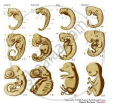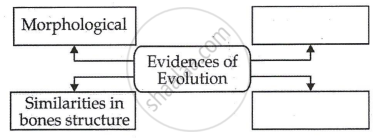Advertisements
Advertisements
Question
Give scientific reason.
Peripatus is said to be the connecting link between Annelida and Arthropoda.
Solution
- Peripatus is the connecting link between two different groups - Annelida and Arthropoda.
- It shows annelid-like characters such as segmented body, thin cuticle, and parapodia-like organs.
- It also shows arthropod-like characters such as tracheal respiration and open circulatory system.
Therefore, Peripatus is said to be the connecting link between Annelida and Arthropoda.
APPEARS IN
RELATED QUESTIONS
(a) Select the analogous structures from the combination given below:
(i) Forelimbs of whales and bats
(ii) Eyes of octopus and mammals
(iii) Tuber of sweet potato and potato
(iv) Tuber of Bougainvillea and tendrils of Cucurbita
(b) State the kind of evolution they represent
With the help of any two suitable examples explain the effect of anthropogenic actions on organic evolution.
Can the wing of a butterfly and the wing of a bat be considered homologous organs? Why or why not?
Differentiate between analogous and homologous structures.
Select and write analogous structures from the list given below :
1) Wings of butterfly and birds
2) Vertebrate hearts
3) Tendrils of Bougainvillea and Cucurbita
4) Tubers of sweet potato and potato
Out of bacteria, spider, fish and chimpanzee, which organism has a better body design in evolutionary terms? Give reason for your answer.
The organs which perform different functions but have the same basic structure are known as :
(a) homologous organs
(b) analogous organs
(c) homolytic organs
(d) analytic organs
The organs which perform similar functions but have different basic structure are called :
(a) asymmetric organs
(b) analogous organs
(c) homologous organs
(d) homophonic organs
One pair of organs in the following animals are not homologous. This is :
(a) forelimbs in humans and lizard
(b) forelimbs in lizard and frog
(c) wings in butterfly and bat
(d) wings in bat and bird
X, Y, and Z are three animals. The animal X can fly but animal Y can only run on ground or walls. The forelimbs of animals X and Y have the same basic design but they are used for different purposes such as flying and running respectively. The animal Z became extinct an long time ago. The study of fossils of Z tells us that it had some features like those of X and some like those of Y. In fact, Z is said to form a connecting link in the evolutionary chain of X and Y.
(a) What could the animals X, Y and Z be?
(b) What name is given to the forelimbs like those of X and Y which have the same basic design but different functions?
(c) Name one feature in which Z resembled X.
(d) Name one feature in which Z resembled Y.
(e) Which is the correct evolutionary chain involving X, Y and Z : X → Z → Y or Y → Z → X?
The organs P and Q of two animals have different structures but similar functions. On the other hand, the two organs R and S of two other animals have the same basic structure but different functions.
(a) What are the organs like P and Q known as?
(b) Name the organs like P and Q. Also name the animals which have such organs.
(c) What are the organs like R and S called?
(d) Name the organs like R and S. Also name the animals which have such organs.
Read the following statement and justify same in your own words with the help of suitable example.
There is evidences of fatal science among chordates.
Observe the picture and answer the following questions.
A) Which evidence of evolution is shown in the picture?
B) What can be proven with this proof?
C) Give one more example of evidence of evolution
Answer the following question.
Wisdom teeth : Vestigial organs :: Lungfish : ....................
Draw a labelled diagram of T.S. of a leaf showing Kranz anatomy.
Define fossil.
Define phylogeny.
Answer the following question:
What are homologous structures? Give an example. Is it necessary that homologous structures always have a common ancestor? Justify your answer.
Find an odd one out.
Name the parts shown in the diagram.
Human jaw

What is carbon dating?
Which evidence of evolution is shown in the given picture? Explain the importance of this evidence.

The degenerated and non-functional organs found in an organism are called ______.
Homologous organs and vestigial organs are examples of ______ type of evidence in evolution.
Which of these is not a vestigial organ in human beings?
- Define vestigial organs.
- Write names of any two vestigial organs in the human body.
- Write name of those animals in which these vestigial organs are functional.
Homologous organs are:
Palaeontological evidence for evolution refers to the ______.
Evolutionary convergence is the development of:
Flippers of Penguins and Dolphins are examples of:
What were the characteristics of life forms that had been fossilised?
While creation and presence of variation is directionless, natural selection is directional as it is in the context of adaptation. Comment.
The evolutionary story of moths in England during industrialisation reveals, that 'evolution is apparently reversible'. Clarify this statement.
Complete the following diagram:

I am the connecting link of annelida and arthropoda. What is my name?
Complete the following conceptual picture:

Give examples of homologous organs and analogous organs in plants.
